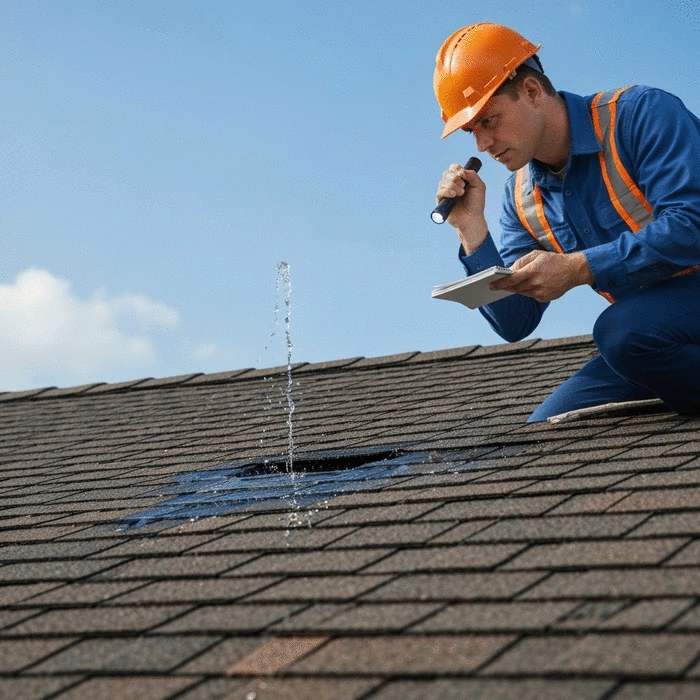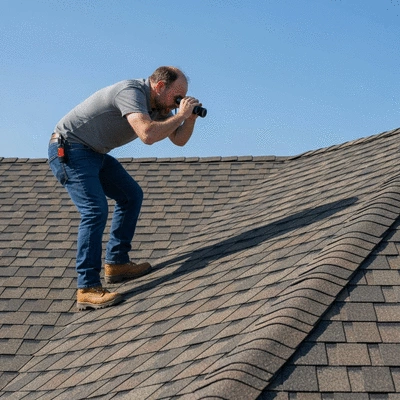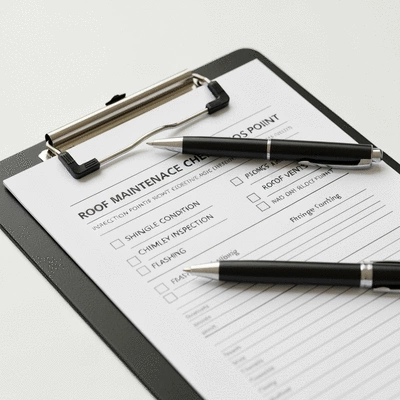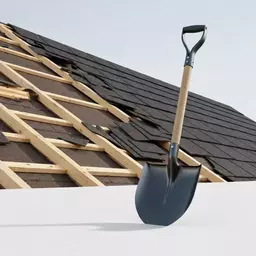Identify and Fix Roof Leaks

Posted on: 2025-10-28
By: Jordan M. Knox
As a homeowner, recognizing the signs of roof leaks early can prevent costly repairs and extensive damage. Being proactive in managing your roof's condition is essential. Here’s what you will learn about identifying and addressing roof leaks effectively:
What You Will Learn
- Common indicators of roof leaks include water stains, sagging ceilings, and peeling paint.
- A simple roof inspection process involves checking both indoors and outdoors for visible damage.
- Utilizing a roof inspection checklist ensures thoroughness in identifying potential issues.
- Regular inspections and timely repairs can significantly extend the life of your roof.
Roof Leak Indicators and Inspection Steps
Understanding the signs of a roof leak and the process for inspection can help homeowners prevent extensive damage. Below is a visual summary of common indicators and a simple inspection guide. For a more comprehensive approach to maintaining your roof, explore our roof maintenance inspection guide.
Common Indicators of Roof Leaks
- ✓ Water stains on ceilings/walls
- ✓ Sagging or bulging ceilings
- ✓ Peeling or bubbling paint
- ✓ Mold/mildew growth in attic
- ✓ Missing shingles or damaged flashing
Simple Roof Inspection Guide
- Start indoors: Check ceilings/walls for stains/dampness.
- Go outside: Inspect roof for visible damage (shingles, sagging).
- Examine gutters/downspouts: Clear debris for proper drainage.
- Look for mold/mildew spots.
- Perform checks after heavy rain for leaks and pooling.
Recognizing the Early Signs of Roof Leaks
As a homeowner, it’s essential to stay vigilant about the health of your roof. Early detection of roof leaks can save you a lot of money and stress down the road. Have you ever noticed water stains on your ceiling or walls? These can be signs of a serious issue that needs immediate attention.
Other common indicators include sagging ceilings and peeling paint. It’s important to act quickly when you see these signs, as they often lead to more significant problems if left unchecked!
Common Indicators of Roof Leaks You Shouldn't Ignore
- Water stains on ceilings or walls
- Sagging or bulging ceilings
- Peeling or bubbling paint
- Mold or mildew growth in the attic
- Missing shingles or damaged flashing
When these indicators surface, it’s a signal to check your roof thoroughly. Ignoring them could lead to costly repairs and long-term damage!
How to Conduct a Simple Roof Inspection
Conducting a roof inspection doesn’t have to be daunting! Here’s a simple step-by-step guide you can follow:
- Start indoors: Check for any water stains or dampness on your ceilings and walls.
- Go outside: Inspect the roof for visible damage, such as missing shingles or sagging areas.
- Examine gutters and downspouts: Clear debris to ensure proper drainage.
- Look for spots of mold or mildew, which can indicate trapped moisture.
- Perform checks after heavy rain: Look for leaks and pooling water.

By following these steps, you can gain a better understanding of your roof's condition and take action where needed. Remember, periodic inspections can prevent small issues from evolving into big problems! For additional guidance, consider these seasonal roof maintenance tips for homeowners to keep your roof in optimal condition year-round.
Utilizing a Roof Inspection Checklist for Thoroughness
A roof inspection checklist can greatly enhance your inspection process. Here are critical areas to cover:
- Check flashing around chimneys and vents.
- Assess the condition of gutters and downspouts.
- Inspect the underlayment and decking for signs of wear.
- Look for damaged shingles or tiles.
- Check for any vegetation growth on the roof.
Having a checklist ensures you don't miss any important aspects during your inspection. It’s a straightforward way to keep your roof in top shape and prevent those pesky leaks!
Effective Techniques for Identifying Roof Leaks
Identifying roof leaks promptly can save you the headache of extensive repairs. Let’s dive into some effective techniques!
We Want to Hear From You!
What do you think about the importance of regular roof inspections? Share your thoughts below:
Frequently Asked Questions About Roof Leaks
What are the most common signs of a roof leak?
The most common signs include water stains on ceilings or walls, sagging or bulging ceilings, peeling or bubbling paint, mold or mildew growth in the attic, and missing shingles or damaged flashing on the exterior.
How often should I inspect my roof for leaks?
It's recommended to perform a thorough roof inspection at least twice a year, typically in the spring and fall. Additionally, check your roof after any severe weather events.
Can I fix a roof leak myself?
Minor roof leaks, such as those caused by a single missing shingle, can often be addressed with DIY repairs. However, for extensive damage, multiple leaks, or safety concerns, it's best to consult a professional roofing contractor.
What should I do immediately if I discover a roof leak?
Immediately place a bucket or container under the leak to catch water. Move furniture or valuables away from the affected area. Then, begin the process of identifying the source of the leak for repair or contact a professional.
What is the purpose of a roof inspection checklist?
A roof inspection checklist ensures that all critical areas of your roof, such as flashing, gutters, downspouts, shingles, and ventilation, are thoroughly checked, minimizing the chance of missing potential issues.
Summarizing Key Points on Roof Leak Management
As we wrap up our discussion on roof leak management, it’s crucial to understand the importance of early detection and timely repairs. Identifying and addressing roof leaks as soon as they appear can save you from significant damage and costly repairs down the line. Always keep an eye out for those telltale signs—like water stains or sagging ceilings—that indicate something is amiss. Remember, the sooner you act, the better!

To ensure your roof remains in optimal condition, regularly inspect it and look for potential issues. By being proactive about maintenance, you not only extend the life of your roof but also safeguard your home’s overall integrity. So, let’s recap some key points:
- Conduct regular inspections to catch leaks early.
- Utilize advanced tools and techniques for accurate leak detection.
- Document any damage for future reference and insurance claims.
- Learn basic repair techniques to address small issues promptly.
Taking Action: Next Steps for Homeowners
Now that you’re equipped with essential knowledge about roof leak management, it's time to take action! I encourage you to assess your roof. Use the techniques we discussed to identify any areas of concern. If you find issues that you’re not comfortable handling, don’t hesitate to reach out to a professional roofing contractor. The expertise they bring can make all the difference in keeping your home safe and secure. For guidance on finding the right expert, refer to our article on selecting your roofing contractor wisely.
Resources for Further Assistance
To aid you in your roofing journey, here are some reputable resources you might find helpful:
These resources will help you take the necessary steps whether you’re tackling repairs yourself or looking for professional help.
Understanding Homeowner Tips for Effective Roof Maintenance
As a homeowner, it’s important to adopt some practical tips for maintaining your roof's integrity. Here are a few that I recommend:
- Keep gutters clean and free of debris to prevent water backup.
- Trim overhanging branches to reduce the risk of damage.
- Ensure proper attic ventilation to prevent moisture buildup.
- Schedule professional inspections at least once a year.
By incorporating these tips into your routine, you’ll be better equipped to maintain your roof and avoid costly repairs in the future. Remember, at Roofing Explained, we are here to help you navigate your roofing needs with confidence!
Recap of Key Points
Here is a quick recap of the important points discussed in the article:
- Regularly inspect your roof to catch leaks early.
- Be aware of common indicators of roof leaks, such as water stains and sagging ceilings.
- Utilize a checklist for thorough roof inspections, covering all critical areas.
- Learn basic repair techniques to address minor issues promptly.
- Document any damage for future reference and insurance claims.
 Ever faced the daunting task of removing old roof shingles? The right tool can transform this labor-
Ever faced the daunting task of removing old roof shingles? The right tool can transform this labor-
 Have you ever stopped to think about how your local weather might be silently dictating the lifespan
Have you ever stopped to think about how your local weather might be silently dictating the lifespan
 Have you considered how your roof can affect your home's comfort and energy efficiency? Understandin
Have you considered how your roof can affect your home's comfort and energy efficiency? Understandin
